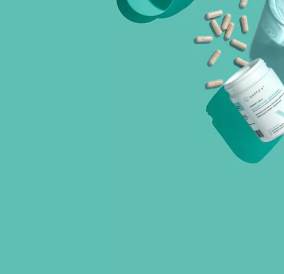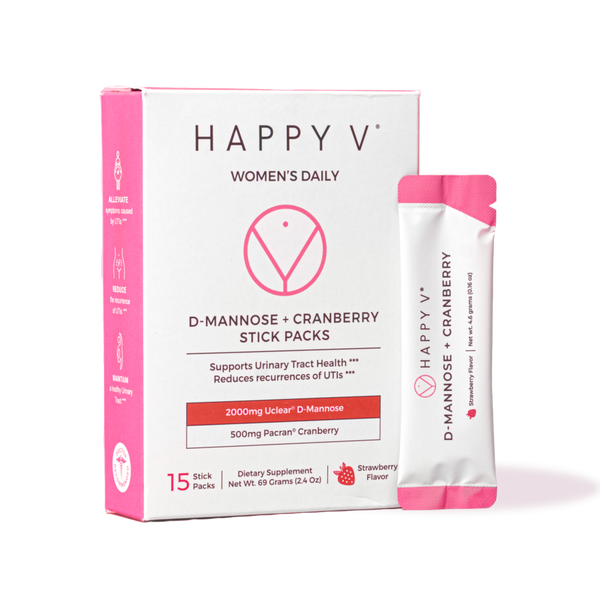- Fact Checked
- December 06, 2022
- 10 min read
Table of Contents
Even though millions of women experience bacterial vaginosis (BV) or a urinary tract infection (UTI) every year, these infections don’t commonly come up in everyday conversations. As a result, many women feel embarrassed or ashamed when they develop an infection, fearing they signify unhealthy sexual or hygienic practices. The truth is, both BV and UTIs can occur even in women who are not sexually active. That’s because the risk factors for these infections include everything from sexual activity to use of feminine hygiene products to the type of birth control pills used to your unique genital anatomy.
If something doesn’t feel right down there, don’t let embarrassment keep you from getting help from a medical professional, if necessary. The first step to getting the right treatment is learning to identify the differences between these infections, so you can get a proper diagnosis and start the right treatment plan as soon as possible.
What is Bacterial Vaginosis (BV)?
Let’s start with an important question: What is bacterial vaginosis? BV is a very common type of vaginal infection caused by an overgrowth of bacteria in the vagina. A third of all women will experience BV in their lifetime.
BV occurs when anaerobes, or harmful bacteria, outnumber the number of healthy bacteria naturally present in the vagina, called lactobacillus bacteria. Lactobacillus is a species of bacteria that releases lactic acid and hydrogen peroxide in the vagina, which keeps the vaginal environment slightly acidic and prevents bad bacteria from growing and causing an infection. If lactobacillus levels become low, a BV infection can occur.
Symptoms of BV
Many women with BV don’t experience symptoms, but there are some common signs of infection that many may notice, including:
- Abnormal vaginal discharge, with a color change from white discharge to thin grey discharge
- Unpleasant vaginal odor often described as a fishy odor
- Change in vaginal pH
- Pain, itchiness, or burning in or around the vagina
- A burning sensation when urinating
Diagnosing Bacterial Vaginosis
Bacterial vaginosis must be diagnosed by a medical provider. If you seek treatment for BV, they may perform one of the following tests to diagnose your infection:
- pH test. Normal vaginal pH is around 4.5. A medical provider may test your vaginal pH using a pH paper to see if your vaginal pH is higher than expected, which could indicate a BV infection.
- Wet mount test. In this test, a sample of vaginal discharge is checked for bacteria by seeking out white blood cells, and clue cells. If clue cells are present, it may mean you have BV.
- Whiff test. In the whiff test, a special solution is added to a sample of vaginal discharge. If an unusual ionic or metallic odor occurs, BV is likely present.
Treatment Options for BV
Prescription antibiotic medications are the most common treatment method for BV. However, antibiotic treatment is not always the best option for BV. That’s because prescription medications like antibiotics can’t target specific bacteria, meaning they may kill healthy bacteria like lactobacillus as well as harmful bacteria. If your body’s lactobacillus levels grow low, you may be susceptible to other other common forms of vaginitis, including vaginal yeast infections or recurrent BV.
The most common antibiotics prescribed for BV are metronidazole and clindamycin. If you seek treatment from a medical provider for your BV infection, it’s important to share your medical history with your provider so they ensure they prescribe you the best treatment to reduce your unhealthy vaginal bacteria.
Natural Treatment Options for BV
Due to the risks associated with taking antibiotics for BV, it’s understandable that many people would prefer to use natural treatment options for a BV infection. Fortunately, there are evidence-based natural options that may help you manage a new or recurrent BV infection.
- Probiotics: Probiotics for vaginal health provide healthy strains of bacteria to your vaginal flora so your body’s natural defenses against infection remain strong. Taking a probiotic supplement is a great way to introduce new lactobacilli to the body. If you want to do more than just take a supplement, you can also pair it by adding probiotic-rich foods into your diet such as yogurt, kefir, and kimchi.
- Prebiotics: Prebiotics are the dietary fibers and glucose that probiotics consume in order to make lactic acid and hydrogen peroxide. By adding prebiotics to your vaginal wellness routine, you ensure that your body’s healthy bacteria strains are nourished.
- Cranberry supplements: Cranberries are filled with amazing antioxidants known as proanthocyanidins. Proanthocyanidins maintain your vaginal wellness by preventing bacteria from sticking to the urinary tract and creating a biofilm. This means cranberry juice or cranberry pills for BV help you flush bad bacteria out of your body.

What is a Urinary Tract Infection (UTI)?
A urinary tract infection is an infection occurring in any region of the urinary tract such as the urethra, bladder, ureters, or kidneys. Most UTIs occur in the lower region of the urinary tract near the bladder and urethra but, if untreated, they can spread to the kidneys and cause a kidney infection.
UTIs occur when bacteria that usually live inside the digestive tract make their way to the urinary tract. The bacteria E. coli causes up to 90% of all UTI cases. (1) These bad bacteria latch on to the urinary tract using a hook-like arm known as the flagellum hook. Once the bacteria latch on, other bacteria then begin to latch onto each other creating a dense biofilm of bacteria. This biofilm makes ridding the body of a UTI more challenging.
Technically, UTIs are not vaginal infections since they occur in the urethra, bladder, and kidneys. However, because the bacteria can stem from the vaginal microbiome, this infection may be directly related to your vaginal health.
Common Symptoms of UTIs
While UTIs have some symptoms in common with BV infections, they also have some distinct symptoms that set them apart, including:
- A frequent urge to urinate
- Strong smelling urine
- A burning or stinging sensations while urinating
- A change in the urine’s appearance from clear and pale yellow to cloudy and dark yellow or reddish pink
- Pelvic pain, especially in women
- Nausea, vomiting, and chills
Diagnosing a UTI
If you see a medical provider to diagnose your UTI, they may do one of the following tests:
- Urine sample analysis. A doctor may conduct a lab analysis to look for white blood cells, red blood cells, or bacteria present in your urine, since these can indicate a UTI.
- Bacteria cultures. In this test, a medical provider may use a bacteria culture to determine which bacteria is causing your infection and determine which medication would be most effective for treating it.
- Urinary tract imagery. If you’re experiencing recurring UTIs that aren’t responding well to medication, your doctor may want to conduct a more advanced screening test to understand what the underlying problem is. These tests may include an ultrasound, a computerized tomography scan, or magnetic resonance imaging test.
- Cystoscopy. If the above tests are not yielding results, your doctor may perform a cystoscopy. A cystoscope is a long, thin camera that is inserted in your urethra and passed through to your bladder.
Treatment Options for UTIs
Between 25–50% of UTIs go away without any treatment. However, if you continue to have symptoms, it’s important to seek treatment, since severe infections can cause kidney failure or even death. There are many antibiotic medications used to treat UTIs, including trimethoprim, fosfomycin, nitrofurantoin, cephalexin, and ceftriaxone. However, as explained above, antibiotics can clear your body of healthy bacteria as well as E. coli bacteria.
A more natural treatment option for UTIs is to take cranberry pills for vaginal health with lots of water. Water can help flush E. coli out of your urinary tract, while cranberry supplements can help clear up the common symptoms of a bladder infection or kidney infection without any side effects.

Can UTIs and BV Cause Each Other?
BV and UTIs are very different infections, but unfortunately, they are related—bacterial vaginosis can trigger recurring urinary tract infections. (2) That’s because Gardnerella vaginalis, the bacteria responsible for causing BV, has the ability to activate hidden E. coli from a previous UTI, which can multiply and cause a recurrent UTI. This means BV and UTIs can occur together—and according to research, about 42.27% of women with BV also experience a concurrent urinary tract infection. (3)
Although E. coli can also cause BV, it is very unlikely that E. coli from a UTI can travel to the vagina to cause bacterial vaginosis. This diminishes the chance of developing bacterial vaginosis as a result of an already present UTI.
Unfortunately, the antibiotics commonly prescribed to treat a UTI do not work well against G. vaginalis bacteria, so treatment for a UTI may not treat an underlying BV infection.
How To Prevent BV and UTIs
If you experience a BV infection or UTI, don’t blame yourself—these infections are common and can occur regardless of any prevention measures taken to ward them off. However, there are some lifestyle practices you can try to decrease your risk for getting one of these uncomfortable infections.
- Take a probiotic supplement. Probiotics encourage the growth of good bacteria that help fight off infection-causing bacteria. Eating foods full of probiotics like yogurt and/or taking a probiotic supplement may help to prevent BV and BV-associated UTIs.
- Drink plenty of water. Drinking lots of water increases the frequency you must use the bathroom, which helps to flush out bad bacteria from the urinary tract and prevent UTIs.
- Avoid drinks that irritate the bladder. Drinks such as coffee, soda, and alcohol may take a toll on the bladder. If you’re experiencing an active infection, try to limit your consumption of these drinks.
- Don’t use harsh soaps. The use of any soaps containing harsh chemicals in your sensitive vaginal area may cause irritation which can result in an infection. Instead, wash the genital area with warm water alone.
- Don’t douche. Douching can force an infection deeper up the urinary tract, and it can clear your urinary or vaginal tract of good bacteria.
- Use protection during intercourse. Using condoms or dental dams can help prevent the spread of bacteria between sexual partners, which can reduce your chance for developing BV, a UTI, or even sexually transmitted infections.
- Keep the vaginal environment dry. Change out of bathing suits, sweaty workout clothes, and wet panty liners fast, and wear dry cotton underwear when possible. Moisture causes bacteria to grow, which can increase your risk of infection.
Keep Your V Healthy With Happy V
If you experience symptoms of BV or a UTIs, contact your healthcare provider as soon as possible for medical advice. They can help you determine an ideal course of treatment to prevent worsening symptoms or a severe infection.
For a natural treatment option, try Happy V. Happy V’s probiotic for vaginal health is formulated with a targeted blend of probiotic and prebiotic bacterial strains to ensure your body’s healthy bacteria levels stay high and prevent infection.
Our experts continually monitor the health and wellness space, and we update our articles when new information becomes available.
- Published on: December 06, 2022
- Last updates: February 08, 2025
Written by Happy V Team
Edited by Happy V Team
Our experts continually monitor the health and wellness space, and we update our articles when new information becomes available.
- Published on: December 06, 2022
- Last updates: February 08, 2025
Written by Happy V Team
Edited by Happy V Team









